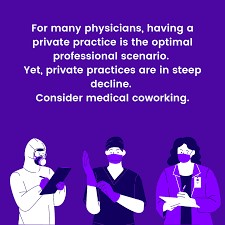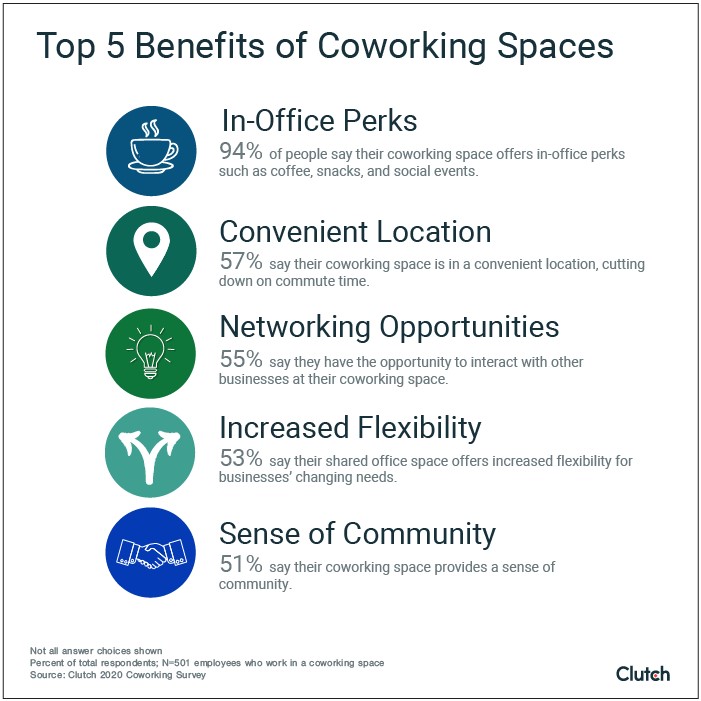
- Date: Oct 12, 2020
- Category:
The medical sector is the fastest growing sector of our society. From the advancements of medical tools and technologies to organizing paperwork of the patients through various software, everything is witnessing a positive change for the welfare of the system. The goal is direct and clear – provide maximum customer satisfaction. Not just this, the aim is also to provide a modern outlook to medical workspaces and the healthcare professionals, leaving behind the traditional bureaucratic methods. It is believed that the number of medical co-working spaces is likely to reach 20,000 this year (2020) and cross 40,000 by the end of 2024, leveraging an annual growth rate of 21.3 percent. The co-working model is great for healthcare industry as it will enhance the flexibility and maximize the productivity of the healthcare professionals.
But what is medical co-working precisely?
“Medical Co-working is about creating a better place to work, and, as a result, a better way to work. Medical Co-working spaces provide more than just office space. They are community centers, friendly gathering places, think tanks. When you rent a desk or an office, you gain co-workers to bounce ideas off and that support you professionally in a way that you can’t find working from home or in the corporate office. Co-working connects you to a global network of professional peers.” By – Jamie Orr, Founder of Tahoe Mountain Lab
Why Medical Co-working is the need of the hour?
Co-working or collaborative work environment is one of the most sought after alternate for newcomers of the medical industry. These shared workspaces provide them opportunities to increase their client base and become a prominent name. The medical industry works on the trust factor. Therefore, with the help of a co-working space, you can build your credibility.
The constant problem that the medical sector faces is the overindulgence in private practice. It is considered to be the final professional stage for them to have a private clinic to practice. It is analyzed that less than half of the practitioners from the US-owned their medical practice, which was the first time in the US’s medical history that physician practice ownership was the minority arrangement.
Medical Co-working offers a plethora of benefits ranging from financial backup to operational work relief. The huge cost-cutting concept fits well for co-working spaces making it the best alternative to pick for healthcare professionals.
A lot has been spoken and gathered about the method of co-working, which has received a warm welcome by all sorts of industries, including healthcare. But what needs to be understood is how it works, and what it actually means in real-life experience. Let us pick the few key features of modern co-working medical spaces to have an in-depth analysis of its truest meaning.
A particular type of co-working: Co-working is a method where an entrepreneur or any small business, rent up space in a workplace along with other entrepreneurs’. You can share the same roof or building and other resources like the pantry area, printer, rent, and other utility areas. Medical co-working is kind of a similar concept as applied to medical practices. Many medical practitioners share the same workspace but work differently and independently. It’s a workspace where one physician requires a waiting room, equipment, furniture, front desk reception area, office cleaning, and maintenance staff. These are common requirements for any medical professional. Therefore medical co-working space takes the lead to soothe the budget from expanding as well as making the workspace more lively and professional.
Medical Co-working, a trend to stay for long! Why?
1. A way to Hold the Right Focus and Serve Patients Better:
Medical co-working allows you to run an office that is pre-managed on a lot of grounds and lets you focus on the right things. Many companies run such co-working spaces like Lina, which allows you to decrease the extra time spent on managing an office significantly and enables you to spend more time on patients, and your healthcare business. Medical co-working spaces allow practitioners to focus on the services they provide rather than the operational aspects.
2. A Strategy to Build Stability from Financial Risks of Private Practice:
To set up a medical workspace, a lot of cost goes into renovation, tools, furnishing, healthcare devices, and more. The cost of rent and office equipment is an add-on. The method of co-working space releases you from the burden of financial risk. It would be best if you simply began working with necessities, and rest is taken care of by the co-working spaces. You can come with technology, tools, and staff to run a productive medical organization. The process of cost-sharing allows practitioners to meet the right needs and not worry about paying bills and running errands. Starting a new healthcare venture could be too risky as it requires huge capital, and co-working spaces share the financial risk with you just as they share your work station.
3. A Concept to Enhance Hospital’s Productivity and Services:
One of the most beneficial elements of working in a medical co-working space is that you can be more attentive to real needs. If you are a new practitioner and haven’t served many patients yet, you can simply choose a part-time plan that enables you to work on selective days only. As the number of patient’s increases, you can easily add more days or hours until you have a dedicated client-base to call for a full-time workspace. This saves time and resources from getting under-utilized. Medical co-working spaces discard the idea of taking massive loans or taking medical offices on lease for a considerable amount. You simply need to pay for what you use and work in a productive manner.
4. A Method to Build a Medical Network of Healthcare Professionals:
It can be really stressful for medical professionals to work as they burn energy and productivity due to prolonged working hours. It becomes even more complicated for solo practitioners as they are alone and lack the support of passionate professionals to boost morale. A co-working space surrounds you with like-minded healthcare professionals who are working with the same objective but in their respective specialities. Considering the challenges are tough on medical practitioners, a co-working space will ease out the stress level and create a network to work in support of each other. Above this, a medical co-working space can leverage the benefit of in-house referrals that will maximize the patients and grow your venture.

Medical co-working is a new wave that has brought immense benefits along. A lot of countries have welcomed this trend with open arms.“It was very essential for us to differentiate ourselves within the market as a co-working model for physicians rather than another medical group or office sharing. As a Co-work Medical agency, we are able to make our model explicitly communicated and easier to comprehend. Thereby allowing healthcare professionals to acknowledge us for what we have to offer, a co-working practice model as an exceptional alternative to employed model to allow physicians and doctors to maintain their autonomy,” as claimed by coworkmedical, a co-work providing firm.
Difference between Medical co-working and Traditional working set up
Medical co-working is a concept developed on the past issues faced by medical professionals related to financial, operational, and administrative functions of medical space. This directly diminished the productivity of the physicians and changed their mindset due to the burden of other aspects. In today’s time, with the emergence of the medical co-working system, healthcare professionals are less stressed and more focussed on patient experience. They focus on educating patients about the illness or disease and seeking a systematic diagnosis to serve the patient better. As per the Vitals survey, physicians with top ratings have an average wait time of about 13 to 15 minutes, while the ones with low ratings have an average wait time of more than 35 minutes. However, it is less to do with ratings as 1 out of 5 patients change their doctors due to prolonged waiting time.
Medical co-working can organize diverse specialties of healthcare professionals like neurologists, Pediatricians, Physical therapist, General physicians, and much more all under one roof.

1. Medical co-working is filled with benefits as they offer a wide range of professionals from different fields in the same space. This brings convenience to the patients and adds value to their overall experience. In the case of the traditional workspace, an independent practitioner works alone to arrange the space and can only serve as one unit.
2. In medical co-working, different healthcare practitioners share their views, knowledge, and insights to bring a change and serve the society in a much-improvised manner. However, in the traditional workspace, the professional lack the opinion of others and offer limited progress.
3. Medical co-working spaces share the burden of finances, staff, and other related requirements. This lessens the role of one professional and divides it evenly. It allows them to focus on their professional role in a better way, unlike in traditional methods where an independent professional is liable for maintaining everything.
4. Co-working spaces are less risky in terms of financial aspects than traditional workspaces.
5. In a co-working medical space, you can maximize your patients through other professionals working in the same building. You can also get noticed automatically. However, in the case of traditional office space, you lack such opportunities.
We can sum up that medical co-working has a set of benefits over a traditional workspace as you do not need to juggle multiple roles all at once and stay less burdened with extra cost. A healthcare professional’s primary role is to stay focused on serving the patient in the most exquisite form, and that comes at ease in co-working workspaces.
Why Should You Choose Medical Co-working?
Let’s categorize the answer to this under two major sections to understand the actual perks of indulging in the medical co-working system.
- Instant Benefits
- Long term Benefits

1. Instant Benefits:
There are multiple instant benefits of medical co-working, such as:
Financial Benefits: For practitioners looking to expand their venture, financial barriers are bound to happen. The medical co-working helps to eradicate the instant burden of spending money as set up cost, which is majorly spent on space and staffing. It takes long for practitioners to cover the spent funds and generate revenue in the initial years of the business. Therefore, many medical professionals switch to co-working space rather than traditional offices to save extra cost and generate quick revenue.
Operational Benefits: As said above, practitioners need to have less pressure on functional requirements. With the help of medical co-working, physicians and medical professionals can speed up their professional practices and work efficiently. This can be of extreme value and relief for practitioners to work in a focused manner and not be pressurized by other work matters.
Professional Benefits: The model of medical co-working lets practitioners establish a network that allows them to receive more patients through their colleagues. This benefits them in networking professionally with fellow practitioners and also expand their business.
2. Long term Benefits:
There are a plethora of long term benefits of medical co-working trend, such as:
Financial Benefits: One of the most prominent long-term benefits of medical co-working is the financial aspect as the constantly growing patients will set a spiking revenue rate. This may take the form of saving finances in staffing, medical supplies, technological cost, and patient care. The longer the co-working model is put to use, the better the financial stage it will lead you to. There is no chance that independent physicians should not choose the co-working system over separate practices.
Operational Benefits: The constant need to run regular operations of a healthcare workplace is not going to reduce or come to an end. To manage these administrative and operational skills, the medical co-working model acts as a benefit. In the long run, the constant update of workspace quality and other related services needs to be improved. For this purpose, the co-working model is suited best as you do not have to stress over the operational aspects and simply provide quality practice to patients.
Professional Benefits: The ability to enable healthcare members to work with flexible work schedules adds productivity to healthcare start-ups and established ones and motivates them to perform better. Allowing them a healthy work-life balance is an integral part of channeling success. The co-working model for the healthcare industry fits best as it will enable staff and healthcare professionals to work in easy schedules that do not stress them out and boost productivity.

Concluding Note:
Medical Co-working model is the trend that is surely going to last long as the benefits it provides are worth experiencing it. The emergence of a co-working pattern takes care of the healthcare industry and professionals by all means. It also serves overwhelmingly to patients and brings out quality performance.



